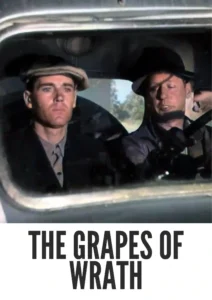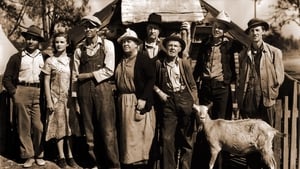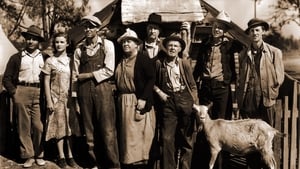Video Sources 0 Views
- Watch trailer
- The Grapes of Wrath 1940 Colorized


Download The Grapes of Wrath (1940) Colorized HD | Henry Fonda | Social Drama Epic
Synopsis
Table of Contents
ToggleDust, Dreams, and Determination: The Grapes of Wrath (1940) in Vibrant Color

Journey through the American heartland with The Grapes of Wrath, a powerful social drama from 1940, now beautifully colorized for a deeply moving viewing experience. This film, based on John Steinbeck’s Pulitzer Prize-winning novel, captures the plight of the Joad family as they migrate from Oklahoma to California during the Great Depression. Known also as Grapes of Wrath, this HD download brings a timeless story of resilience, hope, and the human spirit to your screen.
The Grapes of Wrath Storyline: A Family’s Fight for Survival
The Grapes of Wrath tells the story of the Joad family, who are forced off their land in Oklahoma due to drought, economic hardship, agricultural industry changes, and bank foreclosures during the Great Depression. Led by Pa Joad and Ma Joad, and with the recent release of their son Tom Joad from prison, the family embarks on a long and arduous journey to California, seeking work, land, and a better life.Along the way, they face numerous challenges, including poverty, hunger, exploitation, and loss. Despite these hardships, the Joads remain determined to survive and maintain their dignity. The film explores themes of family, community, social injustice, and the indomitable spirit of the American people. Through their struggles, the Joads find strength in each other and in their shared dream of a better future. The Grapes of Wrath is a poignant and unforgettable portrayal of a dark chapter in American history, reminding us of the importance of compassion, solidarity, and resilience in the face of adversity.
Movie Cast
The film features a stellar cast of actors who bring the Joad family and their world to life:
- Henry Fonda as Tom Joad
- Jane Darwell as Ma Joad
- John Carradine as Casy
- Charley Grapewin as Grampa Joad
- Dorris Bowdon as Rosasharn
Movie Genre
The Grapes of Wrath falls into the genre of social drama, with elements of historical drama and road movie. Its powerful storytelling and realistic portrayal of the Great Depression make it a landmark film in American cinema.
Historical Context: The Great Depression and American Cinema
Released in 1940, The Grapes of Wrath reflects the social and economic realities of the Great Depression, a period of widespread poverty and hardship in the United States. The film was made during a time when Hollywood was beginning to address social issues and explore the lives of ordinary Americans. The Grapes of Wrath is considered one of the greatest films ever made, and remains relevant today for its powerful message of social justice and human dignity.
Colorization Details
This colorized version of The Grapes of Wrath has been meticulously restored using modern digital techniques, enhancing the visual impact while preserving the film’s original atmosphere. The colorization process involved carefully analyzing the grayscale tones of the original black and white footage and assigning appropriate colors to each scene. While the specific software used remains proprietary, the techniques employed included advanced algorithms for color palette selection and image enhancement. This painstaking process brings new life to the characters and settings, making the story even more engaging for modern audiences. While some may debate the merits of colorizing classic films, it introduces these films to a broader audience, ensuring their legacy for future generations.
Technical Details
- Director: John Ford
- Screenplay: Nunnally Johnson
- Based on: The Grapes of Wrath by John Steinbeck
- Cinematography: Gregg Toland
- Edited by: Robert L. Simpson
- Production Company: 20th Century Fox
- Distributed by: 20th Century Fox
- Runtime: 129 minutes
Technical Specifications
- Download Format: MP4
- Resolution: HD (1080p)
- Compatibility: Compatible with most devices, including smartphones, tablets, computers, and smart TVs.
Reviews and Critical Reception
The Grapes of Wrath (1940) is widely regarded as a cinematic masterpiece, earning critical acclaim and numerous awards, including Academy Awards for Best Director (John Ford) and Best Supporting Actress (Jane Darwell). The film is praised for its powerful performances, stunning cinematography, and its faithful adaptation of Steinbeck’s novel. The Grapes of Wrath remains a timeless and important work of art, resonating with audiences for its universal themes of family, survival, and social justice.
FAQs
- Q: What is The Grapes of Wrath about?
- A: The Grapes of Wrath is about the Joad family’s journey from Oklahoma to California during the Great Depression, as they seek a better life.
- Q: Is The Grapes of Wrath (1940) a well-regarded film?
- A: The Grapes of Wrath is considered one of the greatest films ever made, known for its powerful storytelling and social commentary.
- Q: Is this version of The Grapes of Wrath colorized?
- A: Yes, this version has been professionally colorized to enhance the viewing experience.
- Q: What makes The Grapes of Wrath important?
- A: The Grapes of Wrath is important for its depiction of the Great Depression, its exploration of social injustice, and its timeless message of hope and resilience.
- Q: What is the download format?
- A: The download format is MP4, which is compatible with most devices.
- Q: What resolution is the download?
- A: The resolution is HD (1080p), providing a high-quality viewing experience.
Download Now in HD!
Watch The Grapes of Wrath Today!
















